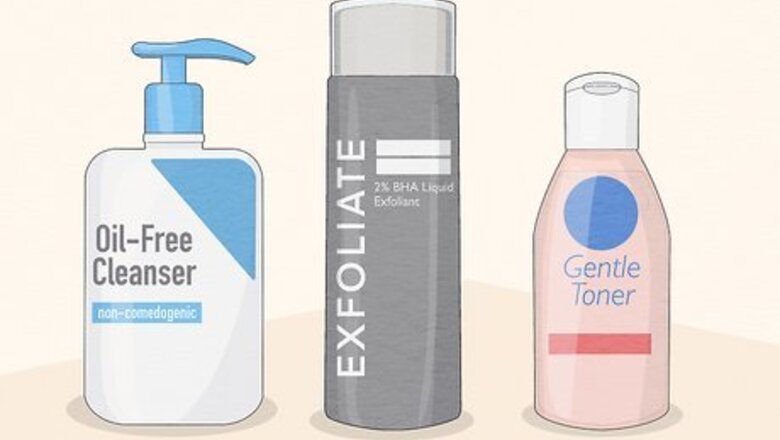
views
- Wash your face with a mild cleanser or plain, warm water twice a day (in the morning and before bed) or after you’ve been sweating.
- Apply toner and moisturizer after you wash your face to protect and replenish your skin. Exfoliate 1-2 times during the week to remove dead skin cells, too.
- Supplement your routine with skin-healthy habits like staying hydrated and getting a good night’s sleep each night during the week.
Building a Skincare Regimen
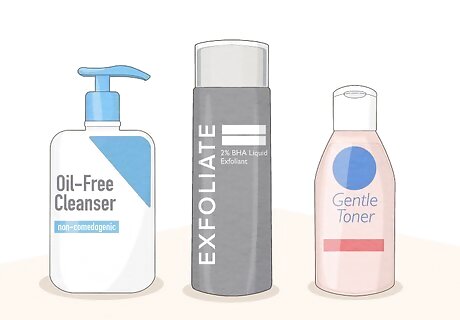
Buy a cleanser, toner, exfoliator, and moisturizer for your skin type. If you're looking for the most effective way to get clearer skin in a pinch, look at commercial options first. Determine your skin type, then look for products designed to clear it up without irritating it (recommendations below). To build a fast, skin-clearing routine, you’ll need: A mild cleanser For oily or combination skin, try a lightweight, oil-free product. For dry skin, go for a rich, moisturizing face wash. For sensitive or acne-prone skin, try non-comedogenic cleansers that don’t have any pore-clogging ingredients. An exfoliant For sensitive, acne-prone, or dry skin, use a chemical exfoliant. For oily, combination, or average skin, choose a chemical exfoliant or an exfoliating facial scrub (either type is safe for these skin types, so go with whichever works best for you). Toner For dry, sensitive, acne-prone, or average skin, grab an alcohol-free toner. For oily skin, use an astringent or alcohol toner. For combination skin, try an astringent on oily patches and a gentler, alcohol-free toner on drier patches. Moisturizer For oily, combination, sensitive, or acne-prone skin, use a lightweight, oil-free moisturizer or gel. For dry skin, use a rich facial cream or lotion. Regardless of skin type, look for moisturizers with an SPF of at least 30 to protect your skin from sun damage.
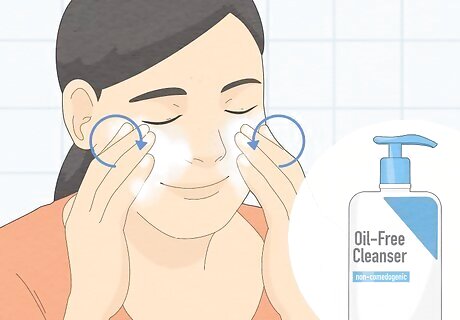
Wash your face with your cleanser to begin your skincare routine. A good cleanser gets rid of bacteria in your skin without overdrying your face. Wet your face with warm (not hot) water, then pump some cleanser into your hands and rub them together until they get a little sudsy. Then, gently rub your face with the cleanser for around a minute using gentle pressure and small, circular movements. Make sure the cleanser is spread evenly, then rinse your face clean with warm water. Avoid hot water, since it can strip your skin of natural oils and leave it dehydrated. If you don't have a cleanser, try an antibacterial soap as a temporary alternative (most soaps that aren’t designed for your face are too harsh and drying to use regularly).
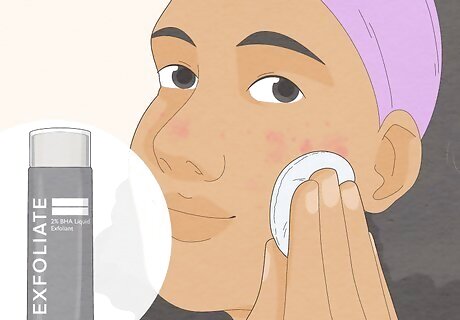
Exfoliate your skin after washing your face 1-2 times per week. An exfoliator scrubs away dead skin particles, leaving your face much smoother and your pores much clearer than before. Simply wet your skin, then apply the product to your face with your hands, rubbing in small circular motions for about 30 seconds. Rinse your face clean with warm water. If you have an exfoliating face wash, just swap it in for your normal cleanser 1-2 times per week. Exfoliating more often can irritate and dehydrate your skin. Chemical exfoliators contain alpha and beta hydroxy acids, and are generally preferred by dermatologists because they're designed to affect the skin on a deeper level than physical exfoliators like a loofah. Exfoliators work fast and usually leave your skin looking a bit fresher and brighter immediately after use. Try working a physical exfoliator like a scrub or loofah into your daily shower. Massage your face with it once your facial pores have been opened by the heat. Your face will feel noticeably smoother afterwards.
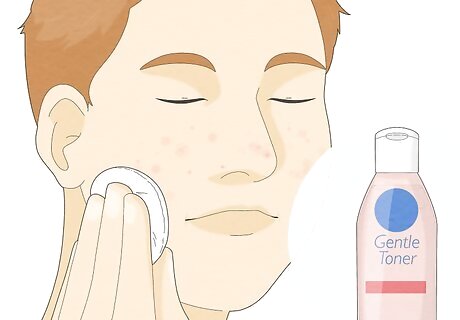
Apply a toner to further cleanse and balance your facial skin. A good toner will help restore your skin's natural pH balance, minimize the visibility of pores, and fight redness and dry patches. Put a few drops of toner on a cotton pad or ball and apply it gently to your entire face after exfoliating (or after washing your face on a non-exfoliating day). If you have oily skin, use an astringent toner to remove excess oil. Astringents often include alcohol and salicylic acid and are found at supermarkets or drugstores. Use an alcohol-free toner if you have dry skin (astringents run the risk of drying out your skin even more). If you're unsure which toner is right for you, check with a dermatologist to get a professional opinion.
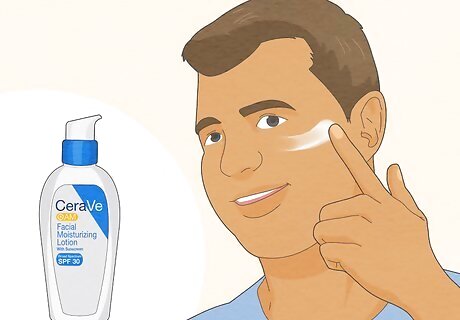
Put on a moisturizer with SPF, even if you have oily skin. SPF moisturizer maintains your skin’s natural moisture barrier and protects your face from irritation and sunlight throughout the day. When your face is still slightly damp from cleansing and toning, rub a thin layer of moisturizer into your skin. If you have oily skin, try a light, non-comedogenic moisturizer. If you skip this step, your skin may continue overproducing oil to make up for the lack of moisture. If you have dry skin, look for moisturizers with richer, thicker formulas (they’ll usually have the word “lotion” in the name). Use a thin, light moisturizer for daytime and summer, and thicker formulas for nighttime and winter.
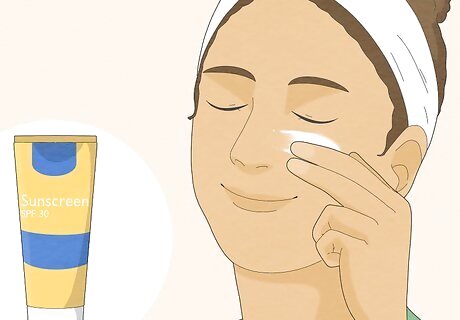
Repeat your cleansing ritual twice daily for a week. If you're looking to get visibly clearer skin in a week, carry out the cleansing ritual twice every day—once in the morning, and a second time at night before bed. This doubles the amount of cleansing during the week and keeps progress from being lost during sleep. Keep your face clean and moisturized throughout the day. Wash your face after sweating, and reapply moisturizer if your skin feels tight or dry. Touch your face as little as possible, and make sure to wash your hands before you do. Your hands can transfer oil and bacteria, potentially causing new pimples and blemishes. If it's hot outside, be sure to wear a sunscreen with an SPF of at least 15 on top of your regular moisturizer. EXPERT TIP Joanna Kula Joanna Kula Licensed Esthetician Joanna Kula is a Licensed Esthetician, Owner and Founder of Skin Devotee Facial Studio in Philadelphia. With over 10 years of experience in skincare, Joanna specializes in transformative facial treatments to help clients achieve a lifetime of healthy, beautiful, and radiant skin. She is also a contributing author for the prestigious Les Nouvelles Esthetiques & Spa magazine and has been featured in a number of magazines including InStyle. Joanna Kula Joanna Kula Licensed Esthetician For extra help clearing your skin, schedule an appointment with an esthetician. Everyone's skin is different, so there isn't a one-size-fits-all approach to getting clear skin. If you only have one week to clear your skin of blemishes, consider scheduling an appointment with a professional esthetician.
Lifestyle Changes
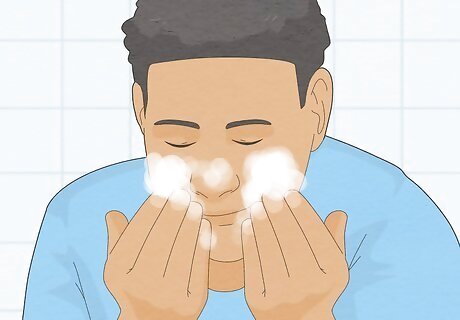
Make skincare a regular habit to keep your skin clear long-term. Once your skin has cleared up, continue washing, exfoliating, toning, and moisturizing regularly to keep it that way! At minimum, wash your face twice a day most days (especially if you’re prone to acne) and after working out. Try to exfoliate your face once a week and put on toner and moisturizer in the mornings, too.

Lower your stress levels and get lots of sleep to prevent breakouts. Chronic stress makes your skin more sensitive and can lead to uncontrollable breakouts. To combat this, set aside time each day to do something you enjoy or to meditate and clear your mind. Scale back on your to-do list and aim to get at least 8 hours of quality sleep each night. Quality sleep allows for better cell turnover in your face skin, which keeps it looking fresh each morning. Reducing stress is good for your skin long-term, even though it may take more than a week for the results to show. Keeping your stress low helps other acne-fighting products and treatments work more effectively.
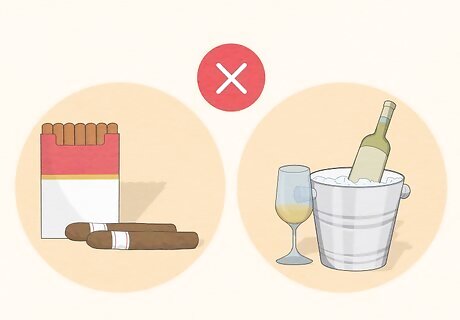
Quit smoking and cut back on alcohol. Smoking is all kinds of bad for your skin—it makes it look paler, older, wrinklier, and less able to recover after injuries or breakouts. Similarly, alcohol is dehydrating and can make your skin more sensitive. Cut back on alcohol and smoking to make your skin more radiant and resistant (your lungs and liver will thank you, too!).
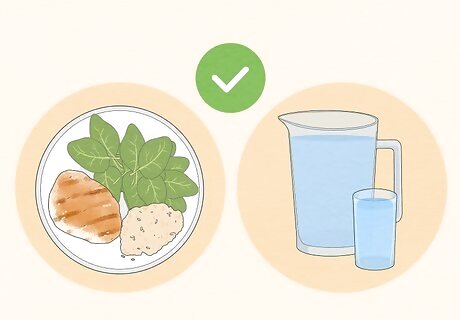
Eat a lean, healthy diet and drink lots of water every day. The link between water and clear skin is strong—aim to drink 11.5 cups (2.7 liters) of fluids a day for women (or 15.5 cups (3.7 liters) for men) to stay hydrated and keep your skin healthy. The link between diet and skin is less clear, but it’s suggested that eating lots of fruits, vegetables, whole grains, and lean protein like fish and chicken is beneficial to your complexion, too. When it comes to eating fats, focus more on fish oil (or fish oil supplements) and fats from nuts, seeds, and vegetables (like olive oil or avocados). Avoid unhealthy fats and processed carbs.
Using Natural Products
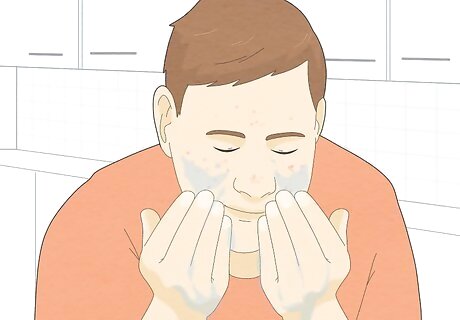
Wash your face with warm water if you’re sensitive to commercial products. For some people, store-bought cleansing products are too harsh and cause irritation (or even allergic reactions). The good news is, plain water can be a stress-free substitute! Try washing without a cleanser unless you’ve been sweating heavily, have visibly dirty skin, or have used heavy cosmetics (then, you’ll need a trusty face wash). Just make sure the water isn't too hot, as this can strip your face of necessary, natural oils. Splash and rub the water on your face, or soak a clean towel in warm water and apply to your face. Washing with plain, warm water can still open and clear your pores, help you retain moisture, and save some money on skincare products. A plain water wash is the simplest DIY remedy you can try before resorting to store-bought creams, particularly if money is a concern.
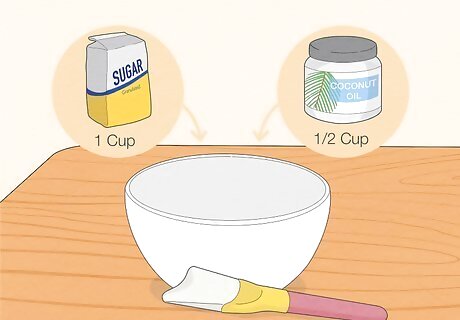
Make your own exfoliator with sugar and coconut oil. Chances are, you already have everything you need to make a sugar-based exfoliator at home! Mix 1 cup (200 g) of sugar into ½ cup (118 mL) of coconut oil. Try brown sugar for the finest, least abrasive scrub, regular granulated sugar for something coarser, or organic sugar for the most intense scrub. To use the scrub, splash some water on your face and rub the mixture on each cheek in a circular motion for one minute each. Optionally, add zest from a citrus fruit or a few drops of vanilla or tea tree essential oil for a fresh scent. Coconut oil contains skin-healthy Vitamin E and has natural antimicrobial properties that leave your skin clean, fresh, and soft.
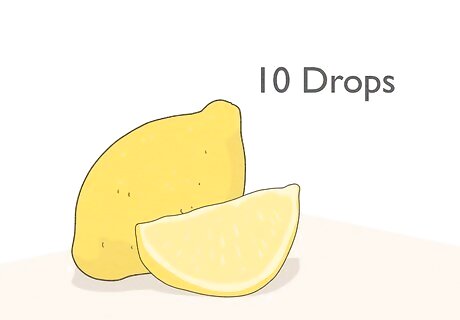
Use lemon juice in place of a toner. Squeeze a lemon and apply some of the juice to a cotton ball, then rub the juice onto your face just like you would with a toner. If you have sensitive or dry skin, dilute the lemon juice with water first. Let the lemon juice sit on your face for a few minutes, then rinse it away with warm water and pat your face dry. Make sure to keep the lemon juice away from your eyes or any cuts on your face—it’ll burn! The lemon juice will clear away dirt particles your cleanser may have missed. It also has antimicrobial properties, Vitamin C to fight breakouts, and astringents and acids that chemically exfoliate your skin. Alternatively, try apple cider vinegar in place of lemon juice.
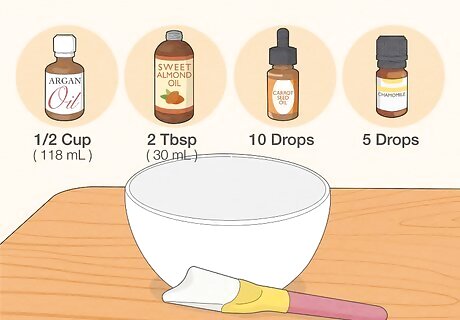
Try a homemade, oil-based moisturizer for dry, irritated, or blotchy skin. Gather ½ cup (118 mL) of argan oil, 2 tablespoons (30 mL) of sweet almond oil, 10 drops of carrot seed oil, and 5 drops of chamomile essential oil. Mix the argan and almond oils together in the container you plan to use for storage, then add the carrot seed and chamomile oils and stir. Apply the mixture to your face or any part of your body that needs some extra moisture. Spread a thin layer on your face, and rinse away any excess with warm water. Store in a dark space away from heat for up to 6 weeks. If you have oily or combination skin, a DIY moisturizer may not be very helpful (especially an oil-based one). Try a lightweight, oil-free product from the store instead.
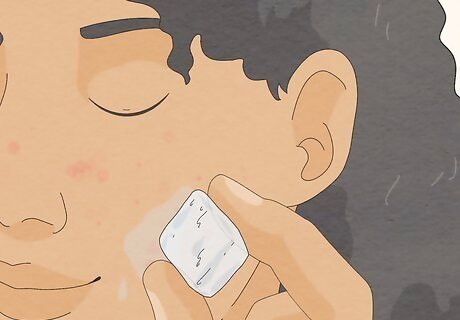
Finish your cleanse by rubbing an ice cube on your face. Wrap a cube (or several) in a thin cloth, then rub the cloth in circular motions around your entire face. This will close your facial pores again and keep dirt and bacteria from getting in. Ice also reduces puffiness, makes under-eye bags lighter, and brightens your complexion. Think of this step like patching up an airlock; now that you've opened up your skin and cleared out the muck, you need to close your pores back up again so your progress isn't undone. If ice cubes aren't available, splash some cold water across your face (it likely won’t be as effective, though).
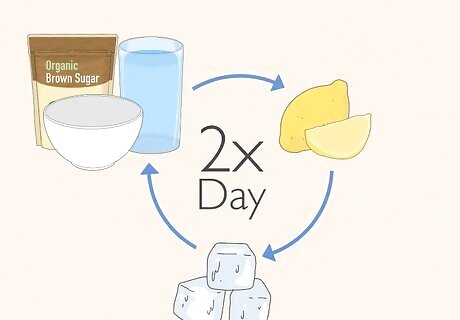
Repeat this routine twice every day for a week. By making a bi-daily routine of this process, you're effectively doubling the amount of progress you can make in getting clearer skin than if you were just doing it once in the morning. Think of your morning cleansing as a “prep and protect” routine, and your nighttime cleansing as a “cleaning and restoring” routine. Splash and wash your face with warm water throughout the day after you’ve been sweating. Since you’re just using water, you don’t have to worry about over-washing or drying out your skin. By the end of a week, even if your skin has not cleared up entirely, you’ll still see a noticeable improvement in the clarity of your skin.












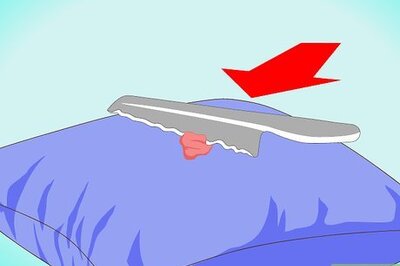

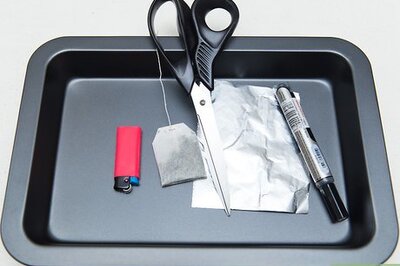





Comments
0 comment